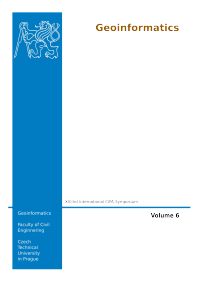Cultural Heritage Recording Utilising Low-Cost Closerange Photogrammetry
DOI:
https://doi.org/10.14311/gi.6.24Keywords:
close-range photogrammetry, heritage recording, orientation sensor, low-cost, smartphonesAbstract
Cultural heritage is under a constant threat of damage or even destruction and comprehensive and accurate recording is necessary to attenuate the risk of losing heritage or serve as basis for reconstruction. Cost effective and easy to use methods are required to record cultural heritage, particularly during a world recession, and close-range photogrammetry has proven potential in this area. Off-the-shelf digital cameras can be used to rapidly acquire data at low cost, allowing non-experts to become involved. Exterior orientation of the camera during exposure ideally needs to be established for every image, traditionally requiring known coordinated target points. Establishing these points is time consuming and costly and using targets can be often undesirable on sensitive sites. MEMS-based sensors can assist in overcoming this problem by providing small-size and low-cost means to directly determine exterior orientation for close-range photogrammetry. This paper describes development of an image-based recording system, comprising an off-the-shelf digital SLR camera, a MEMS-based 3D orientation sensor and a GPS antenna. All system components were assembled in a compact and rigid frame that allows calibration of rotational and positional offsets between the components. The project involves collaboration between English Heritage and Loughborough University and the intention is to assess the system’s achievable accuracy and practicability in a heritage recording environment. Tests were conducted at Loughborough University and a case study at St. Catherine’s Oratory on the Isle of Wight, UK. These demonstrate that the data recorded by the system can indeed meet the accuracy requirements for heritage recording at medium accuracy (1-4cm), with either a single or even no control points. As the recording system has been configured with a focus on low-cost and easy-to-use components, it is believed to be suitable for heritage recording by non-specialists. This offers the opportunity for lay people to become more involved in their local heritage, an important aspiration identified by English Heritage. Recently, mobile phones (smartphones) with integrated camera and MEMS-based orientation and positioning sensors have become available. When orientation and position during camera exposure is extracted, these phones establish off-the-shelf systems that can facilitate image-based recording with direct exterior orientation determination. Due to their small size and low-cost they have potential to further enhance the involvement of lay-people in heritage recording. The accuracy currently achievable will be presented also.References
Uzzell, D.L.: Introduction: The Natural and Built Environment. In: Heritage Interpretation, Vol. 1, The Natural and Built Environment, London, Pinter, 1-14, 1989.
Herbert, D.T.: Preface. In: Heritage, Tourism and Society, London, Pinter, xi-xii, 1995.
Power of Place Office, English Heritage: Power of Place: The Future of the Historic Environment, London, Power of Place Office, 50 pages, 2000.
UNESCO: Convention concerning the protection of the world cultural and natural heritage, http://whc.unesco.org/archive/convention-en.pdf, 2009-05-05.
Palumbo, G., Ogleby, C.L.: Heritage at risk and CIPA today: a report on the status of heritage documentation, International Archives of the Photogrammetry, Remote Sensing and Spatial Information Sciences 2004, 35(2004)B5, 239-842.
Bosch, R.et al.: Non-metric camera calibration and documentation of historical buildings. Proceedings of CIPA 2005, Torino, September 2005, 142-147.
Chandler, J.H., Fryer, J.G.: Recording Aboriginal rock art using cheap digital cameras and digital photogrammetry, Proceedings of CIPA 2005, Torino, September 2005, 193-198.
Wackrow, R et al. Geometric consistency and stability of consumer-grade digital cameras for accurate spatial measurement. The Photogrammetric Record 2007, 22(2007)118, 121-134.
Bryan, P., Chandler, J.H.: Cost-effective rock-art recording within a non-specialist environment, International Archives of the Photogrammetry, Remote Sensing and Spatial Information Sciences 2008, 37(2008)B5, 259-264.
Niu, X. et al.: Directly georeferencing terrestrial imagery using MEMS-based INS/GNSS integrated systems, Proceedings of XXIII FIG Congress 2006, Munich, October 2006, 16 pages
Guarnieri, A. et al.: Low cost system: GPS/MEMS for Positioning. Proceedings of FIG Working Week 2008, Stockholm, June 2008, 10 pages.
Schwieger, V., Gläser, A.: Possibilities of low cost GPS technology for precise geodetic applications. Proceedings of FIG Working Week 2005, Cairo, April 2005, 16 pages.
GENEQ Inc.: SXBlue III. Rugged, Bluetooth high accuracy L1/L2 RTK-Mapping receiver. http://www.sxbluegps.com/SXBlue-III-version1.1.pdf, 2011-01-12.
PNI Corporation: TCM 5. Tilt compensated 3-axis compass module, http://www.pnicorp.com/files/ TCM5%20Datasheet_05-14-2009.pdf, 2009-05-30.
Chandler, J. H., Clark, J. S.: The archival photogrammetric technique. Further applications and development, The Photogrammetric Record 1992, 14(1992)80, 241-247.
English Heritage: St. Catherine’s Oratory | English Heritage, http://www.english-heritage.org.uk/ daysout/properties/st-catherines-oratory/, 2011-05-11.
HTC Corporation: HTC - Products - HTC Desire – Specification, http://www.htc.com/www/product desire/specification.html, 2011-05-12.
Konecny, G.: Geoinformation. Remote sensing, photogrammetry and geographic information systems. London, Taylor & Francis, 248 pages, 2003.
Downloads
Published
Issue
Section
License
- Authors retain copyright and grant the journal right of first publication with the work simultaneously licensed under a Creative Commons Attribution License that allows others to share the work with an acknowledgement of the work's authorship and initial publication in this journal.
- Authors are able to enter into separate, additional contractual arrangements for the non-exclusive distribution of the journal's published version of the work (e.g., post it to an institutional repository or publish it in a book), with an acknowledgement of its initial publication in this journal.
- Authors are permitted and encouraged to post their work online (e.g., in institutional repositories or on their website) prior to and during the submission process, as it can lead to productive exchanges, as well as earlier and greater citation of published work (See The Effect of Open Access).

